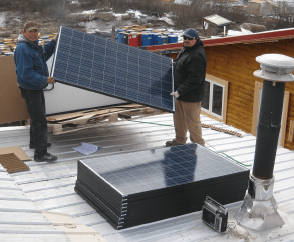Near the confluence of the Yukon and Porcupine Rivers in Fort Yukon, Alaska functions an 18KW grid tied solar electric system. The system was funded through the cooperative efforts of the Gwichyaa Gwich’in Tribal Government, Gwitchyaa Zhee Corporation, the Department of Energy and Tanana Chiefs Conference. In the Spring of 2015, a local five person crew installed the 72 panel array at an optimal 64 degree tilt angle on top of the tribal council office to capture the maximum amount of sun light energy from the far northerly latitude. The DC energy that the solar panels produce is sent through wire that is enclosed in an electrical conduit that runs from the roof, down the exterior wall and into a small room inside the building where the two solar inverters are mounted. The inverters convert the DC electricity into common AC electricity. The AC current is then consumed by the electrical load of the building. The excess solar generated electricity that is not consumed by the load of the building is delivered back to the electrical grid. The inverters are designed to automatically shut down if there is an interruption with the grid power supplied by the utility. This is a built in safety feature that ensures no electricity will be back fed into the system in the event that utility personnel are performing maintenance to the distribution system or in case a grid failure emergency situation occurs. The system is complete with electrical disconnects to isolate the array and an electric meter to monitor production making it a fully code compliant electrical generation system. The inverters are equipped with internet connectivity to monitor and track system performance. The prime months to capture solar energy in Alaska are March through September. Solar electricity, efficiency measures and PCE enrollment were combined to offset 65% of the annual cost of electricity for the tribal council building. Aside from ensuring that the panels are free from snow accumulation beginning early March, there are minimal maintenance intervals for an anticipated 10 years or longer.
Project Funding
- Department of Energy: $105,486
- GZGTC : $94,236.65
- Tanana Chiefs Conference: $11,250
Equipment
- 72 Canadian Solar 250 watt solar panels
- 2 SMA Sunny Boy 10 KW inverters
- Uni-Strut rack mount system
Fuel Oil Savings from Efficiency
- Annually: 786 gallons
- Local value: $4,716 (2018)
Electricity Savings
- Annually: 19,805kwh
- Local value: $13,071 (2018)
Jobs Created
- 100% local hire
Payback Period
- 12 Years
Solar Electric Project Above The Arctic Circle Reduces Demand For Diesel Generated Electricity
Energy Efficiency First

Before the solar electric system was installed, additional loose fill insulation was blown into the attic space bringing the insulation level from an R-21 up to an R-80. The increase in thermal performance is the contributing factor that was able to reduce the fuel oil consumption by 786 gallons a year for space heating. Waste oil is utilized to create space heat for the tribal council building. To reduce the electrical load, 120 florescent light fixtures were replaced with high efficiency LED fixtures. This measure was able to reduce the annual electric cost by $1,733. In addition to renewable energy production, increasing the thermal performance of the building and decreasing the electrical loads, the tribe was also able to save $.18 cents per KWH from their electric bills by enrolling in the Power Cost Equalization program. PCE is a state funded program available to rural residents. It is ultimately sustained by the earnings generated from an endowment fund with performance similar to the Alaska permanent fund.
Project Sponsors
- Tanana Chiefs Conference
- US Department of Energy – Office of Indian Energy
- Gwichyaa Zhee Gwichin Tribal Government
- Gwichyaa Zhee Gwichin Corporation
